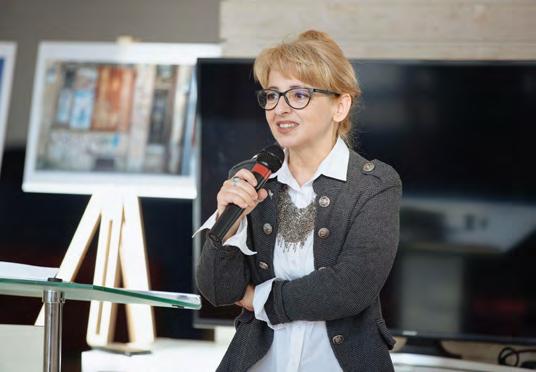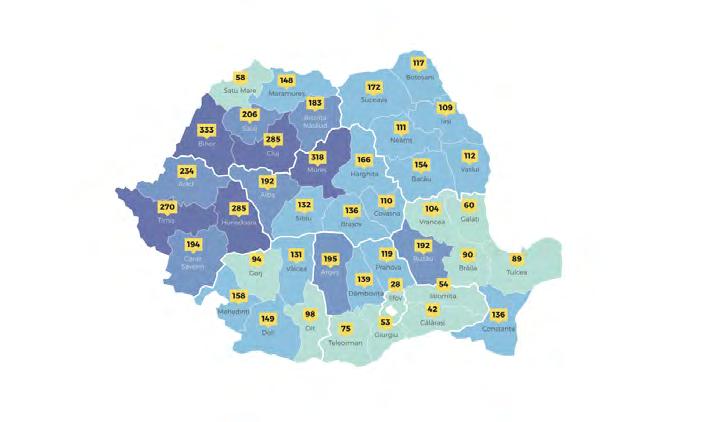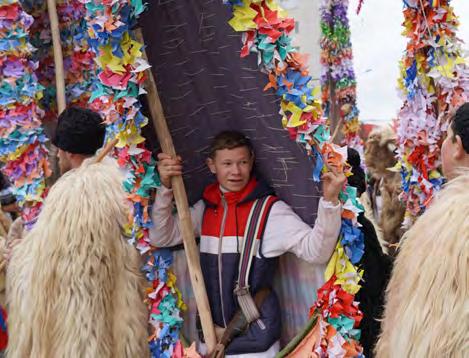
6 minute read
Rural culture crops preserving the cultural life of Romania’s countryside
from BR/03/2022
Last month, the National Institute for Cultural Research and Training (INCFC) launched The Atlas of Culture, a study that aims to expand the mapping of the sector. Following this endeavour, the Institute set itself an important objective of creating an atlas that would provide comprehensive cultural information, along with a long-term course of action and established training teams. Business Review talked to assoc. prof. Ph.D. Carmen Croitoru, the General Manager of INCFC, about the cultural life of the countryside.
By Oana Vasiliu
Advertisement
Can you briefly introduce The Atlas of Culture, its vision, and context?
Almost every study generated and published by the INCFC seeks to complete a huge cultural puzzle that still has many untouched or even unknown areas. It is therefore no accident that the first study we decided to publish out of the Atlas of Culture series had to do with the cultural life of the countryside.
Based on a broad process of statistical data collection, inventory, and structuring, followed by a mixed methodological approach— both quantitative and qualitative—The Atlas of Culture – 1st edition. Cultural establishments in rural areas aims to assess the state of culture by following aspects such as the level of distribution of cultural infrastructure elements; expenditure and investments by local public authorities in culture; profiles of community-level cultural leaders; and the specificity of cultural events.
The study is a wake-up call for authorities who are responsible for access to culture and it seeks to provide support for the promotion of public policies on culture in rural areas.
The Atlas of Culture starts from an existing rural infrastructure element: community centres. What do these institutions represent for Romanian villages and what else did you learn about them through your research?
Community centres are essential elements of public cultural infrastructure in Romanian rural areas, along with communal libraries. More than a century after the first cultural establishments appeared, the network has been extended to most of rural Romania, carrying out or hosting cultural activities.
In 2018, Romania had 6,365 buildings that functioned as rural community centres. Of these, 4,984 buildings (78 percent) were identified as active and 1,381 (22 percent) as inactive (non-operational, un-renovated, unused). And while community centres are spread across 94 percent of Romanian municipalities, very few of them actually operate for the benefit of the community as cultural institutions. The lack of a suitable space for cultural activities fragments the relationship between cultural establishments and citizens and creates distances that are difficult to recover later.
Have there been recent investments in rural cultural infrastructure? How many community centres need either partial rehabilitation or a complete facelift?
Between 2007 and 2018, only 38 percent of territorial administrative units made investments in the infrastructure of community centres through available grant funding programmes. As a result, only 18 percent of community centres have been renovated or modernised through grant programmes. At the same time, most local public spending on cultural establishments is intended for the renovation of buildings, to the detriment of proper staffing and hosting of cultural activities.
The report has found that cultural services in rural areas are inadequately staffed. What solutions are there to cover this deficit?
Only around 40 percent of territorial administrative units have a human resource who is specialised in the cultural field, i.e. a cultural rapporteur or librarian who can coordinate the activity of the local community centre. Moreover, many community centre managers, even those with a cultural background, often also perform other tasks within the local public administration.
The first solution we’ve identified was linking up educational strategies in secondary and higher education (Humanities and Arts) to make sure that young professionals are offered opportunities for cultural placements in rural areas.
Facilitating regular access to continuing vocational training programmes for cultural staff and formally trained specialists for complex cultural intervention in rural areas, with all the social implications of these processes, would also be very helpful.
Last but not least, prioritising the funding of cultural education can encourage citizen involvement in the cultural activities of
their communities, especially among young people.

Are there any specific public policies for culture in rural areas? What models could be transferred to the Romanian countryside?
Even after the adoption of legislation regarding cultural establishments (in 2003 and 2006), there are still legislative gaps concerning the role of cultural establishments and the need for a proper work plan for the training and qualification of specialist staff. These gaps have been doubled by local government’s failure to implement existing legislation, thus affecting the status, authority, and activity of cultural establishments within communities.
Our plea focuses on the idea of formulating coherent and sustainable development policies that include basic social, educational, and cultural elements, which should be implemented by institutions that are able to turn these policies and strategies into reality. It is not that complicated, because all these communities need are strategies that enable primary education institutions, the church, and the community centre to join efforts in order to prevent irrecoverable social gaps. More specifically, we are signalling the need for the adoption of a public policy for rural culture that takes into account the opportunities and huge potential of this type of structure. The same public policy should provide measures to avoid the over-instrumentation or use of cultural funds and infrastructure for electoral purposes, as well as to consult local communities regarding the spending of public money on cultural initiatives.
What does “rural” mean for you? What do rural areas in Romania share with those in other countries in Europe and what are the key differences?
By definition, a rural space is any type of place that cannot be described as urban. But rural areas are much more than that. Before the industrialisation of the early 20th century, Romania was all rural. Our culture is rooted in the rural environment that to this day clings to the fundamental aspects of who we are and where we come from. Rural
spaces in Europe, be they ours or those of our neighbours, are very similar in the sense that they represent the foundations of cultural development—our origins, if you will. Other European countries have already begun to consecrate rural spaces as living beacons of cultural heritage. Romania is in the process of catching up to these other countries, as this is the way forward in ensuring not only the preservation of existing heritage, but also the nurturing of developments in the field.
Some international forums mention rural areas as creative spaces, with opportunities anywhere from renewed agriculture to the arts. Is this the case in Romania, too? Are villages where people have invested in new agricultural tools more open to cultural development?
As cultural heritage is such a multifaceted field, even the smallest investment in a multitude of areas will have a positive impact. For those of us operating in the cultural sector, it’s clear that investments in various fields that are relevant for rural areas have positively impacted cultural development.
In terms of global trends, many artists are pursuing exploratory journeys that take them back to their roots. Have you noticed this type of approach towards the Romanian village?
According to the INCFC’s documentation,
more and more cultural and creative professionals have been moving to rural areas in recent years. For this reason, cultural communities have begun to take shape around these artists’ initiatives. Though this is not included in official statistics on cultural communities in villages, it is undoubtedly positive and contributes to the revival and regeneration of the rural world through culture.









